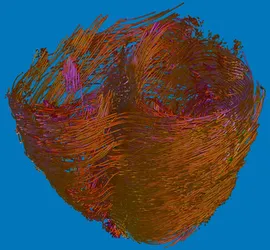Scientific Visualization
Background
Visualization is a key technology to foster exploratory data analysis as it enables the layering of far more data than any other analysis process could. As the visualization is the interface or view into the data, it accommodates better and faster understanding of complex processes and products. Especially in virtual and collaborative workspaces, visualization techniques must be capable of dealing with real-time constraints, both with respect to data analysis, information fusion and rendering aspects.
Research activities in Scientific Visualization cover a variety of different topics common to many areas of science and engineering. Particular interests include the exploration of large-scale data sets as they arise in medical imaging or numerical simulation techniques. In this context our dominant goal is to define Scientific Visualization as a multi-stage pipeline, including data generation and processing techniques as well as mapping and display techniques. Among others, hierarchical approaches and approaches that efficiently exploit parallelism and/or dedicated graphics hardware to interactively generate, process and visualize large-scale data sets are investigated.
In particular, our activities include the following visualization areas:
Volume Visualization
Our goal is to provide interactive, yet high quality volume rendering techniques for large data sets. In particular, we are developing cost effective parallel rendering algorithms on GPUs, and we discovering new algorithms to render unstructured grids and time-varying sequences.
Tensor Visualization
Interactive visualization of diffusion tensor fields is one the most challenging applications in medical imaging. We have developed a particle engine to explore large-scale tensor fields including a number of different visualization options. For about half a million particles, reconstruction of diffusion directions from the tensor field, time integration and rendering can be done at interactive rates. Different visualization options like oriented particles of diffusion-dependent shape, stream lines or stream tubes facilitate the use of particle tracing for diffusion tensor visualization. The proposed methods provide efficient and intuitive means to show the dynamics in diffusion tensor fields, and they accommodate the exploration of the diffusion properties of biological tissue.
Flow Visualization
Besides interactive visualization options for large flow fields, feature extraction and uncertainty visualization in such fields play an important role. Particle tracing including numerically accurate integration schemes has turned out to be a valuable method in this area. The extension to triangular and tetrahedral grids, and the visualization of unsteady flow fields is actually under investigation.

Iso-Surface Extraction and Rendering
By using the latest features of current consumer-level PC graphics cards, we develop novel approaches to indirect volume visualization techniques. Iso-Surface extraction from tetrahedral grids that allows for the interpolation of arbitrary per-vertex values and point-based rendering of high-resolution surfaces from large volumetric data sets and time-varying sequences have been successfully demonstrated.
Terrain rendering
In recent years, the rendering of high resolution terrain data including photo textures has gained increasing attention. In this work we combine the advantages of continuous LOD semi-regular meshes with the advantages of a discrete LOD hierarchy, thus avoiding any re-triangulation of such fields at run-time. The proposed method generates high quality renderings by supporting a continuous LOD representation including photo-texturing. In contrast to previous methods, the terrain is guaranteed to be refined within a user-defined screen- and world-space error. Aliasing is avoided by employing optimal geometry filtering at the best possible geometric resolution. At run-time, discrete sets of decimated mesh structures are transmitted progressively to the GPU, resulting in high bandwidth efficiency.
Publications
- High-Quality Cartographic Roads on High-Resolution DEMs
- Interactive Separating Streak Surfaces
- GPU-Aware Hybrid Terrain Rendering
- GPU-Based Euclidean Distance Transforms and Their Application to Volume Rendering
- Stress Tensor Field Visualization for Implant Planning in Orthopedics
- Interactive Streak Surface Visualization on the GPU
- Exploring the Millennium Run - Scalable Rendering of Large-Scale Cosmological Datasets
- GPU Ray-Casting for Scalable Terrain Rendering
- Real-time Approaches for Model-based PIV and Visual Fluid Analysis
- GPU-Based Real-Time Discrete Euclidean Distance Transforms With Precise Error Bounds
- Efficient Geometry Compression for GPU-based Decoding in Realtime Terrain Rendering
- Computational Steering for Patient-Specific Implant Planning in Orthopedics
- Interactive Simulation and Visualization in Joint Replacement Surgery
- Real-Time Simulation and Visualization of Deformable Objects
- Advanced Volume Rendering for Surgical Training Environments
- Real-Time Editing, Synthesis, and Rendering of Infinite Landscapes on GPUs
- A Generic and Scalable Pipeline for GPU Tetrahedral Grid Rendering
- ClearView: An Interactive Context Preserving Hotspot Visualization Technique
- Advanced Volume Rendering Techniques for Medical Applications
- A Multigrid Framework for Real-Time Simulation of Deformable Bodies
- Realistic and Interactive Simulation of Rivers
- The Application of GPU Particle Tracing to Diffusion Tensor Field Visualization
- Interactive Simulation and Rendering of Heterogeneous Deformable Bodies
- GPU Construction and Transparent Rendering of Iso-Surfaces
- A Multigrid Framework for Real-Time Simulation of Deformable Volumes
- GPU Simulation and Rendering of Volumetric Effects for Computer Games and Virtual Environments
- A Particle System for Interactive Visualization of 3D Flows
- UberFlow: A GPU-Based Particle Engine
- Acceleration Techniques for GPU-based Volume Rendering
- Compression Domain Volume Rendering
- Local exact particle tracing on unstructured grids










